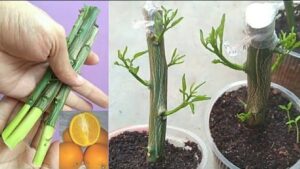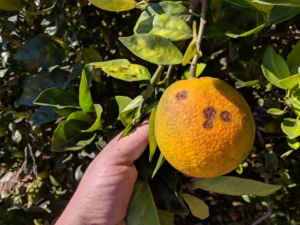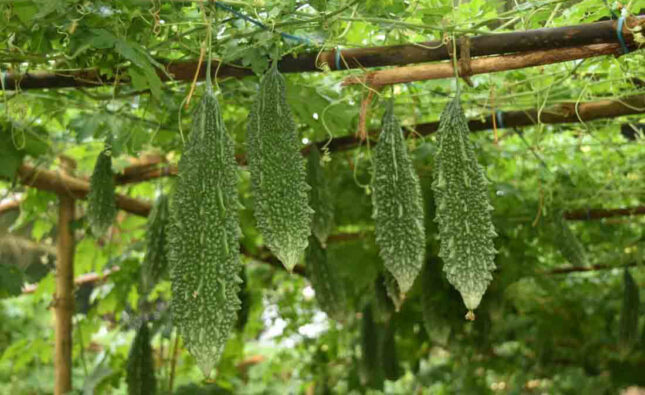Orange Cultivation, Growing Season, Harvesting and Selling Price: A Complete Guide
Orange cultivation, a popular practice worldwide, involves growing citrus trees that bear the sweet and tangy orange fruit. Oranges are not only delicious but also packed with essential vitamins and minerals, making them a nutritious addition to any diet. If you’re considering growing orange trees, here’s a guide to help you get started.
1. Climate and Soil Requirements:
Oranges thrive in subtropical to tropical climates with moderate temperatures ranging from 55°F to 100°F (13°C to 38°C). Frost can damage the delicate citrus trees, so it’s essential to protect them during cold spells. Well-draining, sandy loam soil with a slightly acidic to neutral pH (6.0 to 7.5) is ideal for orange cultivation. Avoid waterlogged or clayey soils, as they can lead to root rot.
2. Site Selection:
Choose a sunny location for your orange grove, as citrus trees require full sun exposure to produce abundant fruit. Ensure the site is sheltered from strong winds, which can break branches and hinder tree growth.
3. Propagation:
Oranges can be propagated through seeds, cuttings, or budding onto rootstocks. For consistency in fruit quality, budding is a preferred method. Use healthy, disease-free scions and rootstocks for successful propagation.
4. Planting:
Plant orange trees during the early spring when the soil is warm and moist. Dig a hole slightly larger than the root ball and place the tree at the same depth it was in the nursery container. Water the newly planted tree generously to help it establish its roots.
5. Irrigation:
Orange trees require regular watering, especially during dry spells. Ensure the soil remains consistently moist but not waterlogged. Using drip irrigation or soaker hoses is recommended to deliver water directly to the root zone.
6. Pruning:
Prune orange trees annually to maintain an open canopy and remove dead or diseased branches. This enhances air circulation and sunlight penetration, reducing the risk of fungal diseases.
7. Pest and Disease Management:
Keep a vigilant eye for common pests like aphids, mites, and citrus leaf miners. Use natural predators or horticultural oils to control infestations. Implementing good cultural practices, such as proper watering and adequate spacing, can help prevent diseases like citrus canker and root rot.
8. Harvesting:
Oranges generally take around 9-12 months to ripen, depending on the variety. They can remain on the tree for several weeks after reaching maturity. Harvest oranges by cutting the stem with pruning shears or picking them by hand to avoid damage.
9. Post-Harvest Care:
Store harvested oranges in a cool, well-ventilated area. They can be refrigerated for extended freshness.
By following these guidelines, you can enjoy a bountiful harvest of juicy, flavorful oranges from your very own grove. Remember, patience and proper care are key to successful orange cultivation. Happy growing!

Commercial Varieties of Orange for Growing in India
India, with its diverse climate and soil conditions, provides an ideal environment for cultivating various orange varieties. Commercial orange cultivation in India has gained momentum due to the rising demand for this nutritious and flavorful citrus fruit. If you are considering growing oranges commercially in India, here is a guide to some popular and well-suited orange varieties for cultivation:
1. Nagpur Orange (Citrus reticulata):
Nagpur orange, also known as “Santra” or “Nagpuri Santara,” is one of the most famous varieties grown in India. It is primarily cultivated in the Vidarbha region of Maharashtra, particularly in and around Nagpur. Nagpur oranges are renowned for their delicious sweetness, vibrant color, and thin skin, making them highly popular in the market. The harvesting season typically spans from November to January.
2. Coorg Mandarin (Citrus reticulata Blanco):
The Coorg Mandarin, also called “Coorg Orange,” is prominently cultivated in the Coorg region of Karnataka. This variety is characterized by its easy-to-peel skin, sweet taste, and intense aroma. Coorg mandarins are generally available from December to March, making them a valuable addition to the Indian citrus market.
3. Kinnow (Citrus reticulata x Citrus sinensis):
Kinnow is a hybrid variety resulting from a cross between “King” (Citrus nobilis) and “Willow Leaf” (Citrus x deliciosa). It is cultivated mainly in the states of Punjab, Haryana, and Rajasthan. Kinnows are known for their high juice content, excellent flavor, and rich nutritional value. The harvesting season for Kinnow extends from December to April, making it a prominent variety in the late-winter market.
4. Malta (Citrus sinensis):
Malta, or “Sweet Orange,” is a widely cultivated variety in several parts of India, including Uttar Pradesh, Andhra Pradesh, and Tamil Nadu. It is valued for its juicy and sweet flesh, as well as its adaptability to various agro-climatic conditions. Malta oranges are typically available from November to February.
5. Blood Orange (Citrus sinensis):
Blood oranges, though relatively less common in India, have gained popularity due to their distinct reddish hue. These oranges contain anthocyanins, the pigments responsible for their unique coloration. Blood oranges are rich in antioxidants and have a slightly tangy, berry-like flavor. Their growing season is relatively shorter, usually from January to February.
6. Valencia Orange (Citrus sinensis):
Valencia oranges are commonly grown in parts of South India, especially in Tamil Nadu and Karnataka. They are appreciated for their sweet and juicy taste, making them suitable for both fresh consumption and juicing. The harvesting season for Valencia oranges typically lasts from February to April.
Harvesting Period of Orange in India
The harvesting time of oranges in India can vary depending on the region and the specific variety of orange being grown. Generally, oranges are harvested during the winter months when they reach their peak ripeness and flavor. In most parts of India, the typical harvesting season for oranges falls between November and February.
Here’s a rough breakdown of the harvesting time for some popular orange varieties in different regions of India:
1. Nagpur Oranges:
Harvested from November to January, with the peak season usually in December.
2. Kinnow Oranges:
Harvested from December to February, with the peak season around January.
3. Khasi Mandarin (Assam):
Harvested from November to January.
4. Malda Fazli (West Bengal):
Harvested from December to February.
Yield of orange
The yield of oranges per hectare in India can vary widely depending on factors such as the region, climate, soil type, farming practices, and the variety of orange grown. On average, the yield of oranges in India ranged from 10,000 to 20,000 kilograms per hectare (10 to 20 tonnes per hectare).
Nutrient values of oranges (per 100 grams) are as follows:
- Calories: 43 kcal
- Carbohydrates: 8.2 grams
- Sugars: 8.2 grams
- Dietary Fiber: 2.1 grams
- Protein: 0.9 grams
- Fat: 0.2 grams
- Vitamin C: 53.2 milligrams (88% of the Daily Value)
- Thiamine (Vitamin B1): 0.087 milligrams (6% of the Daily Value)
- Folate (Vitamin B9): 30 micrograms (8% of the Daily Value)
- Potassium: 181 milligrams (5% of the Daily Value)
- Calcium: 43 milligrams (4% of the Daily Value)
- Magnesium: 10 milligrams (3% of the Daily Value)
- Vitamin A: 225 international units (4% of the Daily Value)
Health Benefits of Orange
Oranges are not only delicious but also packed with essential nutrients and health benefits. Here are some of the key health benefits of oranges:
1. Rich in Vitamin C:
Oranges are a great source of vitamin C, which is essential for a healthy immune system. Vitamin C helps protect the body against infections, promotes wound healing, and supports the absorption of iron from plant-based foods.
2. Antioxidant Properties:
Oranges contain various antioxidants, including flavonoids like hesperidin and beta-carotene, which help combat oxidative stress and reduce the damage caused by free radicals in the body. This can contribute to overall health and reduce the risk of chronic diseases.
3. Heart Health:
The potassium content in oranges can help regulate blood pressure and reduce the risk of hypertension and cardiovascular diseases. Additionally, the flavonoids in oranges may improve blood vessel function and reduce inflammation, which are beneficial for heart health.
4. Digestive Health:
Oranges are a good source of dietary fiber, which aids digestion and supports a healthy gut. The fiber content helps prevent constipation and promotes regular bowel movements.
5. Skin Health:
Vitamin C in oranges is essential for collagen production, which plays a crucial role in maintaining healthy skin. The antioxidants in oranges also help protect the skin from damage caused by UV rays and pollution.
6. Cancer Prevention:
Some studies suggest that the antioxidants and phytochemicals present in oranges may have anti-cancer properties, reducing the risk of certain types of cancer. However, more research is needed to fully understand the extent of this effect.
7. Eye Health:
Oranges contain nutrients like vitamin A, zeaxanthin, and lutein, which are beneficial for eye health. They may help reduce the risk of age-related macular degeneration and cataracts.
8. Hydration:
Oranges have a high water content, which helps keep you hydrated and supports overall bodily functions.
9. Weight Management:
The fiber in oranges can help you feel full and satisfied, making them a good addition to a balanced diet for weight management.
10. Bone Health:
Oranges contain calcium and other minerals important for bone health, contributing to maintaining strong and healthy bones.

Fertilizer and Manure Requirement in Orange Plant
The fertilizer and manure requirements for an orange can vary, depending on factors such as soil fertility, tree age, and local climate conditions. However, here we are providing general guidelines for fertilizing orange plant.
| Age of the Plant in years | N (grams/plan). | P (grams/plan) | K (grams/plan). | Farm yard manure (FYM) in Kg’s. |
| 01 | 152 | 51 | 22 | 10 |
| 02 | 303 | 102 | 52 | 17 |
| 03 | 453 | 152 | 76 | 25 |
| 04 | 603 | 204 | 102 | 12 |
Pest and Diseases in Orange and Its Control
Orange trees are susceptible to various pests and diseases that can affect their growth and fruit production. Proper management and control measures are essential to maintain healthy orange orchards. Here are some common pests and diseases in orange trees and their control methods:
1. Citrus Canker (Xanthomonas citri subsp. citri):
- Citrus canker causes raised lesions on leaves, fruit, and stems, with oily or water-soaked appearance.
- Control: Infected trees should be removed and destroyed to prevent the spread. Copper-based sprays can be applied as a preventive measure.
2. Citrus Tristeza Virus (CTV):
- Citrus Tristeza Virus can cause stunted growth, yellowing of leaves, and death of infected trees.
- Control: Planting virus-free nursery stock, using resistant rootstocks, and controlling aphids (the vector for CTV transmission) can help prevent its spread.
3. Citrus Greening (Huanglongbing, HLB):
- Citrus greening is a severe bacterial disease that causes fruit to remain green, and the tree eventually declines.
- Control: Infected trees should be removed and destroyed. Insecticides can control the vector, the Asian citrus psyllid, which spreads the disease.
4. Alternaria Brown Spot (Alternaria alternata):
- This fungal disease affects the leaves and fruit, causing dark, sunken lesions.
- Control: Fungicides can be applied, and proper sanitation practices like removing and destroying fallen leaves can help reduce its spread.
5. Phytophthora Root Rot (Phytophthora spp.):
- Phytophthora can cause root rot, leading to wilting, decline, and death of the tree.
- Control: Proper soil drainage, avoiding overwatering, and using disease-resistant rootstocks can help manage this disease.
6. Sooty Mold (Capnodium spp.):
- Sooty mold is a black fungus that grows on the honeydew excreted by insects like aphids and scales.
- Control: Managing the insect populations that produce honeydew is essential. Insecticidal soaps or oils can be used to control pests.
7. Citrus Psyllids:
Citrus psyllids are small sap-sucking insects that can transmit the deadly citrus greening disease (huanglongbing). Signs of infestation include distorted leaves and yellow shoots. To control psyllids:
- Use reflective mulch around the base of trees to deter psyllids from laying eggs.
- Release natural predators like ladybugs and lacewings to reduce the population.
- Apply neem oil or insecticidal soaps to control minor infestations.
- For severe cases, use systemic insecticides like imidacloprid, but use them with caution to avoid harming beneficial insects.
8. Citrus Leafminer:
Leafminers are tiny larvae that tunnel through the leaves, leaving characteristic winding trails. The damage weakens the leaves and affects tree health. Control methods include:
- Prune affected leaves and dispose of them to reduce the spread.
- Apply horticultural oils to suffocate the larvae.
- Release natural enemies such as parasitic wasps to control leafminer populations.
9. Citrus Thrips:
Thrips are small insects that feed on citrus leaves and fruit, causing silvering of leaves and scarring on fruit. To manage thrips:
- Remove weeds and grasses near the orchard that can serve as alternate hosts.
- Apply insecticidal soaps or neem oil to control thrips in early stages.
- Insecticides like spinosad can be used if populations are high, but always follow the label instructions.

Post Harvest Management
Sweet oranges can be stored at 7 – 8°C with 85 – 90% RH for 4 – 8 weeks. Sweet oranges may be treated with ethylene gas for de-greening and development of colour. A temperature of 6-7°C, 5-10 ppm of ethylene and 90-95% RH in a de-greening chamber can set a change in colour in about 48 hours.
Selling Price of Orange in India
In general, the prices of oranges in India can range from around INR 20 to INR 80 per kilogram (approximately $0.30 to $1.10 USD per kg) at retail markets. However, during peak seasons or when the supply is high, prices may dip, and during off seasons or low supply periods, prices may increase.






